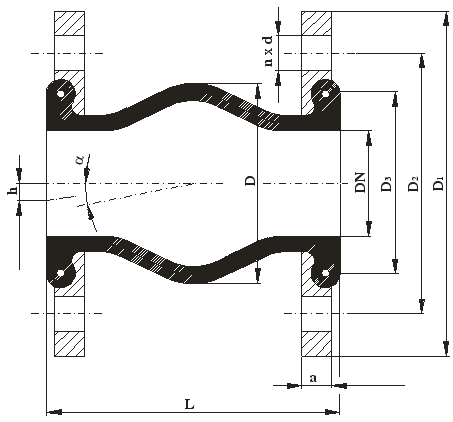
Testing
The expansion joint is tested as per DIN 3230.. |
Application
Fitting t compensate for changes in pipe
length and for pipeline nonalignment, caused
by temperature changes in piping systems. It
dampens vibrations and reduces unwanted
noise caused by the flow of the service fluid in
the pipeline and other sources of vibration
such as pumps, turbines, and compressors.
For use with non-aggressive and aggressive
liquids, vapors and gases, at maximum
pressures of 1,60 Mpa at temperatures up to
110°C, depending on the resistance of the
rubber insert.
Technical description
The expansion joint insert is made of rubber
reinforced with cord warp. Both ends have
reinforcing ring to which flanges are attached
for installation in a pipeline. The expansion
joint can be compressed, stretched, and
shifted perpendicular to the flow axis or
turned through an angle. The limits of
movements are given in the table below.
Connecting and face-to-face dimensions
Face-to-face dimensions are given in the table
below.
Flange connecting dimensions as per
DIN 2501and ČSN 13 1060.
Sealing surfaces are formed by the rubber
insert.
Material
Expansion joint rubber reinforced
with cord fibre
Flanges, bolts carbon steel
Installation
The expansion joint can be installed in
horizontal or vertical piping. If possible, the
counter flanges should cover the whole
sealing surface of the expansion joint. The
internal diameter of the counter flange must
correspond to the internal diameter of
expansion joint otherwise turbulence will
cause pressure loss. During installation it is
essential to make sure that the possible
expansion (contraction) of the pipeline is
within the allowable contraction (expansion)
limits of the expansion joint
|


